Patagonian Fjords—Tierra del Fuego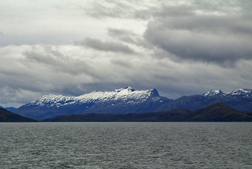 The very words evoke an eye-filling vista of snow-tipped peaks dropping into channels of icy grey-green water, its surface broken by the sudden spout and sound of a southern right whale, or fountained by a mammoth ice block plunging off a glacier face. A place of silent grandeur, and spectacular stark beauty.
The very words evoke an eye-filling vista of snow-tipped peaks dropping into channels of icy grey-green water, its surface broken by the sudden spout and sound of a southern right whale, or fountained by a mammoth ice block plunging off a glacier face. A place of silent grandeur, and spectacular stark beauty.
A perfect introduction, or first step, is a short cruise through the lacework of islands, peninsulas, channels and fjords that make up Tierra del Fuego in Patagonia. New in just the last few years, Patagonia cruises through these waters are mounted exclusively by the Chilean company Cruceros Australis, on two smallish ships, Mare Australis and Via Australis. Each contain 64 cabins, and accommodate a maximum of 128 passengers on three and four day transits of the Straits of Magellan and the Beagle Channel between Punta Arenas, Chile, and Ushuaia, Argentina—the southernmost town on the planet, via Cape Horn, the southernmost point of land on earth.
This is expedition cruising—which means that that instead of shore visits in launches to crowded 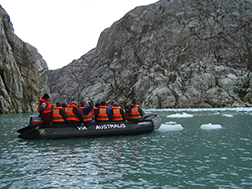 touristicated towns lined with overpriced jewelry and junk souvenir and tee-shirt shops, you’ll crouch on the tubes of a bouncing inflatable Zodiac for a wild ride into a remote beach to explore Indian ruins, look at native flora, and bird-watch on pebbled strands with not another soul save your shipmates around. It means that instead of nights of casino action, disco-clubbing and spa treatments, you’ll participate in lectures and documentary films on Patagonian flowers, recent research into the mystery of how Emperor penguins feed beneath the ice, and the incredible courageous odyssey of Ernest Shackleton to Antartica in 1914.
touristicated towns lined with overpriced jewelry and junk souvenir and tee-shirt shops, you’ll crouch on the tubes of a bouncing inflatable Zodiac for a wild ride into a remote beach to explore Indian ruins, look at native flora, and bird-watch on pebbled strands with not another soul save your shipmates around. It means that instead of nights of casino action, disco-clubbing and spa treatments, you’ll participate in lectures and documentary films on Patagonian flowers, recent research into the mystery of how Emperor penguins feed beneath the ice, and the incredible courageous odyssey of Ernest Shackleton to Antartica in 1914.
We cruised from Ushuaia on the Via Australis in late October, relatively early in the season, which runs from mid-September through April—the Patagonian summer. Boarding at dusk, we were invited to the Sky lounge for a welcome pisco sour, the vaguely Margarita-like Chilean national drink, with the crew. Captain Oscar Stephens and the Chilean crew and expedition team were very welcoming, and extremely friendly and helpful. Each day contains one or two major off-ship activities, and several talks, films, and slide-shows. It’s really a very good short introduction to the history, exploration, early peoples, flora and fauna of Patagonia and the Tierra del Fuego. 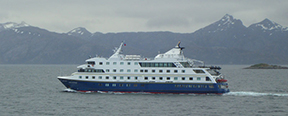 As the ship makes its way through the complicated passages of this convoluted area, the vistas are constant and changing at the same time. Sweeping panoramas of serrated snow-capped peaks and granite fingers piercing the shredded clouds migrate from one set to another. Gnarled, knobby rock, windswept trees, varicolored heather and lichen on steep hillsides plunging into the sea, and nearby groups of rugged rocky islands through which the ship must tortuously wend. The bridge is open to passengers at almost all times, which makes it interesting to watch this process of navigation, and follow the twisting course on pencil-plotted chart, color radar, and GPS.
As the ship makes its way through the complicated passages of this convoluted area, the vistas are constant and changing at the same time. Sweeping panoramas of serrated snow-capped peaks and granite fingers piercing the shredded clouds migrate from one set to another. Gnarled, knobby rock, windswept trees, varicolored heather and lichen on steep hillsides plunging into the sea, and nearby groups of rugged rocky islands through which the ship must tortuously wend. The bridge is open to passengers at almost all times, which makes it interesting to watch this process of navigation, and follow the twisting course on pencil-plotted chart, color radar, and GPS.
We arrived at Cape Horn, the small scruffy island that is the southernmost point of land on earth, our first stop, after a night’s southward sailing. Zodiac landings on the grey shale beach are possible 80% of the time, according to the First Officer—to disembark, climb the hill and view the Albatross-shaped steel memorial to the more than 10,000 sailors who have lost their lives in the passage around Cape Horn over the years, and to look south toward Antartica. We were unfortunately in the unlucky twenty that morning—the winds were gusting to over 50 knots—almost 100 km per hour, and it’s unsafe to unship the Zodiacs, or run them in winds over 30 knots. That’s plenty strong enough that when we exited the side-door to the bridge for a better camera shot, we felt in danger of being blown off. He said that at their last Cape Horn landing, the winds were running almost 100 knots! 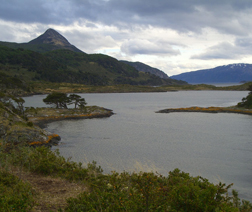
Shore expeditions are of course the highlight of these cruises, along with the constant, amazing views. Depending on the month, duration and direction, you’ll see glaciers, fjords, historical or indigenous peoples sites, Magellanic penguins, elephant seals, and if you’re lucky, right whales. There are of course lots of sea birds such as giant petrels, savin albatross, black and white upland geese, royal terns and beautiful Imperial cormorants with amber crests and regal purple cheeks. A typical day may start with an early wake up call, a quick cup of coffee in the lounge, with full weather gear and life vest on, then down the three sets of steel rear stairs to be handed aboard the pitching Zodiacs by the steadying crew, then off to a shore-side journey to view flora, fauna, glaciers, or spectacular countryside; warming chocolate with brandy as you re-board the ship.
The Australis contain two large comfortable lounges, bar, open decks, and nicely appointed cabins—not huge suites, but relatively large for a small cruise ship, and each with a large picture window to take in the views. Cocktail are made by Andreas, the head barman, with ice chipped off slabs of perfectly clear glacial ice, fished from the foot of various glaciers on the trip. Food is excellent and varied in the dining room, with friendly and efficient service. One picks a table (each seats eight), and sticks with it for the cruise. Nationalities can be quite varied—our cruise had representatives from fourteen nations, and we ended up with two Germans from Frankfurt, and four Spaniards from Barcelona and Bilbao, respectively, none of whom spoke much English. But with our little Spanish and German, and their smattering of English, we got on fam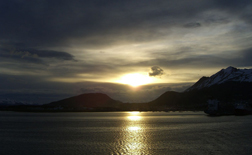 ously. Our waiter Christian was very good about getting orders right—steak cooked as requested, salmon nicely underdone, a substitution happily made for a vegetarian diner when only meats were on the menu.
ously. Our waiter Christian was very good about getting orders right—steak cooked as requested, salmon nicely underdone, a substitution happily made for a vegetarian diner when only meats were on the menu.
As we dined, the Via Australis motored westward through the Beagle Channel, made famous by Captain Robert FitzRoy and Charles Darwin on the second voyage of HMS Beagle in 1932; up the Avenue of the Glaciers in Alberto de Agostini National Park; under the spires of the Cordillera Darwin, from which dozens of enormous rivers of ice spill out and calve into the channel—glaciers with names like Romanche, Germany, Italy, and Netherland, after the home nations of famous early explorers. 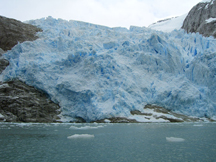 Early on the second day, we watched from the bridge as we entered open sea for a period of an hour or so, where the waves and wind picked up considerably, and the ship pitched and rolled decidedly. Re-entering the archipelago, we steamed up the Cockburn Channel, into Chico Sound and into a narrowing fjord. The ship dropped anchor under mottled sunshine and dramatic clouds, we donned life-jackets, climbed into a bouncing Zodiac held to the rear stair, and sped under lowering skies up the fjord , it’s granite walls ribboned by silvery waterfalls, to its head and the Nena and Pilot glaciers. Advancing glaciers are stunning and otherworldly. The only thing you can call them is ice blue—that intense, almost neon, Paul Newman’s-eyes color that seems to emit from the hundred-year-old ice face exposed above the water’s edge. We sat facing the glacier in the Zodiacs in milky grey-blue water, chocked with ice blocks and stared at the fissures and crevasses, listening to the cracking and popping from stress, and the occasional thunder-crack and roar as a few thousand pounds of ice calved off into the water. The fissured rocks above are home to hundreds of nesting Imperial cormorants, just returning for the summer, and starting their nest-building with a head-bobbing dance of love. The sky had become more threatening, and a hailstorm followed, lending a quite surreal aspect to the scene. One thing said about Patagonia is that you can have all four seasons each and every day.
Early on the second day, we watched from the bridge as we entered open sea for a period of an hour or so, where the waves and wind picked up considerably, and the ship pitched and rolled decidedly. Re-entering the archipelago, we steamed up the Cockburn Channel, into Chico Sound and into a narrowing fjord. The ship dropped anchor under mottled sunshine and dramatic clouds, we donned life-jackets, climbed into a bouncing Zodiac held to the rear stair, and sped under lowering skies up the fjord , it’s granite walls ribboned by silvery waterfalls, to its head and the Nena and Pilot glaciers. Advancing glaciers are stunning and otherworldly. The only thing you can call them is ice blue—that intense, almost neon, Paul Newman’s-eyes color that seems to emit from the hundred-year-old ice face exposed above the water’s edge. We sat facing the glacier in the Zodiacs in milky grey-blue water, chocked with ice blocks and stared at the fissures and crevasses, listening to the cracking and popping from stress, and the occasional thunder-crack and roar as a few thousand pounds of ice calved off into the water. The fissured rocks above are home to hundreds of nesting Imperial cormorants, just returning for the summer, and starting their nest-building with a head-bobbing dance of love. The sky had become more threatening, and a hailstorm followed, lending a quite surreal aspect to the scene. One thing said about Patagonia is that you can have all four seasons each and every day.
That night we steamed up the Madgalena Channel, and into the Straits of Magellan itself, arriving at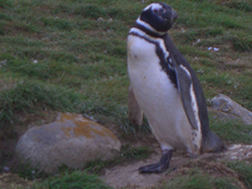 dawn at Magdalena Island, one of the several summer nesting sites of the Magellanic penguins. Biologists estimate that there are currently about 100,000 mating pairs here at the peak of the season, but it was still early, and the birds numbered only in the thousands. The wind was just over the 30 knot limit for Zodiac landing, but the Captain deemed it within the safe zone, and we landed on the black pebble beaches, surrounded by tuxedoed penguins sleek and fast in the water, and hilariously waddling and awkward up the beach and into the nesting grounds. These were mostly males, who arrive first, reclaim and ready the nesting burrows, followed by the females some weeks later. They go through an annual ritual of searching, recognition, and a re-connection mating dance—finding their spouse among the other 49,999 of the opposite sex, after a migratory journey that might total thousands of miles, round trip.
dawn at Magdalena Island, one of the several summer nesting sites of the Magellanic penguins. Biologists estimate that there are currently about 100,000 mating pairs here at the peak of the season, but it was still early, and the birds numbered only in the thousands. The wind was just over the 30 knot limit for Zodiac landing, but the Captain deemed it within the safe zone, and we landed on the black pebble beaches, surrounded by tuxedoed penguins sleek and fast in the water, and hilariously waddling and awkward up the beach and into the nesting grounds. These were mostly males, who arrive first, reclaim and ready the nesting burrows, followed by the females some weeks later. They go through an annual ritual of searching, recognition, and a re-connection mating dance—finding their spouse among the other 49,999 of the opposite sex, after a migratory journey that might total thousands of miles, round trip.
The last night, there was a farewell party, with a raffle of the jack—the small flag which flies at the ship’s bow—and an auction, for a Chilean children’s charity, of the chart used to navigate around Cape horn, penciled with the Mar Australis course, and signed by the captain. The bidding was fairly lively, but I’d set my sights on having this memento of one of the most captivating and spectacular places on earth, and in the end, a small piece of Patagonia was mine to return home with.
